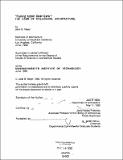| dc.contributor.advisor | David Hodes Friedman. | en_US |
| dc.contributor.author | Mejel, Jalal B. (Jalal Bezee) | en_US |
| dc.contributor.other | Massachusetts Institute of Technology. Dept. of Architecture. | en_US |
| dc.date.accessioned | 2012-01-30T16:42:27Z | |
| dc.date.available | 2012-01-30T16:42:27Z | |
| dc.date.copyright | 1990 | en_US |
| dc.date.issued | 1990 | en_US |
| dc.identifier.uri | http://hdl.handle.net/1721.1/68721 | |
| dc.description | Thesis (M.S.)--Massachusetts Institute of Technology, Dept. of Architecture, 1990. | en_US |
| dc.description | Supervised by David Hodes Friedman. | en_US |
| dc.description | Includes bibliographical references (p. 181-187). | en_US |
| dc.description.abstract | World War II had instigated a strong national movement in The Middle East. In the Fifties and Sixties this region witnessed the end of colonialism in wide spread revolutions. The predominantly agrarian societies of The Middle East were mobilized to modernize. The institutions, with a specific understanding of modernity, mobilized a society with deeply ingrained tradition to change. This intersection of modernity and tradition had produced rich and unique cultural manifestation. A local formulation that captured the essence of this intersection was manifested. This thesis proposes this manifestation as "colloquial" in nature and will aim at recovering it. A reconstruction of the society's cultural history - institutional intervention: physical as in architecture and urban planning; social as in mass media and social programs- of the Fifties and Sixties is necessary to this recovery. Colloquial architecture had a space of aesthetic that was in tune with its cultural history. This has rendered the architectural expression constantly shifting, thus the difficulty of its recovery . This thesis will trace the particularities of colloquial architecture, as they break away from modern and traditional discourses, by alternatively assuming the position of a modernist and traditionalist. Particular methods will be employed to the various discursive fields that will be analyzed. The mode of analysis will be semiological in nature. | en_US |
| dc.description.statementofresponsibility | by Jalal B. Mejel. | en_US |
| dc.format.extent | 188 p. | en_US |
| dc.language.iso | eng | en_US |
| dc.publisher | Massachusetts Institute of Technology | en_US |
| dc.rights | M.I.T. theses are protected by
copyright. They may be viewed from this source for any purpose, but
reproduction or distribution in any format is prohibited without written
permission. See provided URL for inquiries about permission. | en_US |
| dc.rights.uri | http://dspace.mit.edu/handle/1721.1/7582 | en_US |
| dc.subject | Architecture. | en_US |
| dc.title | "Falling upon deaf ears" : the case of colloquial architecture | en_US |
| dc.title.alternative | Case of colloquial architecture | en_US |
| dc.type | Thesis | en_US |
| dc.description.degree | M.S. | en_US |
| dc.contributor.department | Massachusetts Institute of Technology. Department of Architecture | |
| dc.identifier.oclc | 23360604 | en_US |
